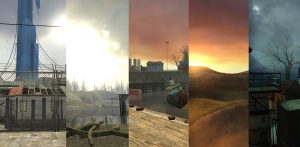User:Jupix/Atmosphere Transitions (level design)
There are many aspects to creating a realistic atmosphere in your game map — light, colors, sounds, architecture, the surrounding world and its story. A successful design of these elements leads to a believable and unique world which the player wants to see, hear, smell and feel. Most games tell a story, and telling the story requires a combination —or rather a series— of distinct atmospheres. All level designers know this, but when all the plans are finished and building begins, a question arises: what ways are there to actually believably make transition from one atmosphere to another? This article tries to answer that question with examples from known titles, including Half-Life 2 and its Mods.
Atmosphere types
Day to Night to Day
Having a dark, cold world for the player to work their way through can have a profound effect on the gaming experience; it adds extra fear for survival and usually makes the player think more of their enemies rather than the surrounding world. It should, however, be noted that the effect of this is as temporary as any. A too long time in the dark makes a map repetitive and bores the player easily. Therefore in Half-Life 2 you will spend most of the time in daylight and only a few maps in night time.
The first occasion of total darkness is in Ravenholm. In this case, the transition between light and darkness is two-way — there's day before and after We don't go to Ravenholm.
Note, though, how the transitions have been handled. The process of turning from day to night starts almost in the very beginning of the game, with gradual change to afternoon, evening and night chapter by chapter. The whole process takes a considerable amount of time. The player can see the whole change and watch the gorgeous sunset before entering Black Mesa East. As usual, the final change to night takes place while the player is inside and has no view of the outside world. By the time the player is in Ravenholm, it is the darkest it will ever be — just right for a nice zombie-fest.
When the player exits Ravenholm and enters the mine, they are not able to see the change from total to mild darkness. It doesn't take too long to play through the mines, but still, when the player exits them, it is a bright morning again. This time the process took considerably less time but was still quite smooth. This was accomplished by having the player work their way through a naturally dark surrounding space, where the process wouldn't be visible anyway. In the very end, when walking up the shaft, the player gets to fully experience the contrast between night and day.
The second instant of dark gameplay is the intense Nova Prospekt, where the above technique is also used, though the transition from day to night is faster. However, the night ends quickly as the player is teleported out of the facility into the bright day of the following week.
Urban to Rural
Busy to Peaceful to Busy
Colorful to colorless
Transition tips
- Don't rush it!
- Sudden changes in atmosphere should only be done in extreme circumstances, i.e. when it's a change as sudden in the storyline, or when a strong emotional reaction is wanted. Spanning the transition over a longer amount of time gives the player time to accept and adjust to the change.
- Don't just use the force!
- All changes in atmosphere should have a logical explanation to them — there should be a visible reason why they're happening. However, bear in mind that you shouldn't underestimate the player. A small hint is often enough; people like mysteries.
- Don't base a map on its atmosphere.
- A level should always have some meaning to it. A reason why it's there. Giving it a respectable atmosphere is done afterwards.
